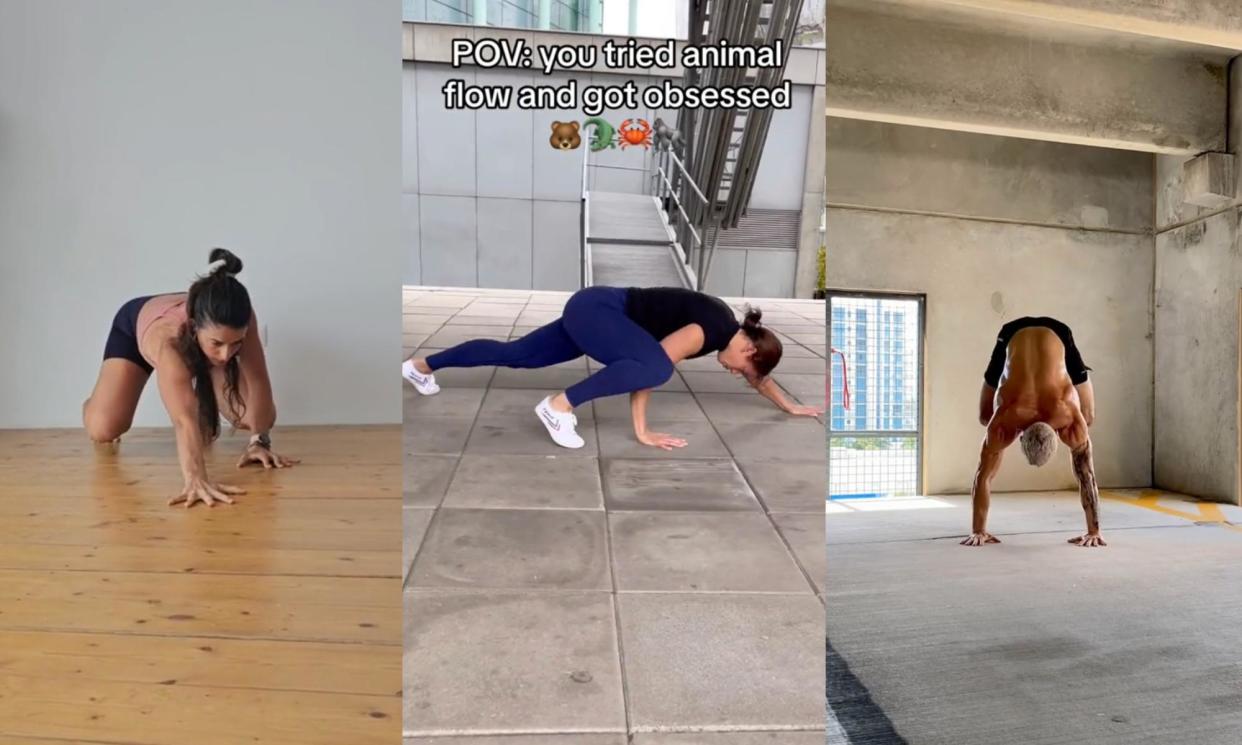Is moving like an animal the secret to good health?

Maybe I was naive, but I thought crawling would be easy. Babies do it, after all, and I’m better than them at most things.
And yet, by my third go crawling across a gym floor in northern Bethesda, I was disabused of my confidence. My arms and legs burned, my breath was ragged and sweat dripped down my face even though the AC was cranked up. Also, I was doing it wrong.
Related: Never write yourself off! 25 things I’ve learned about getting fit – after almost 60 years of sloth
“Reset,” said Marcus Vilmé as my limbs tangled. Vilmé is a certified personal trainer and instructor of Animal Flow, a bodyweight workout in which the practitioner moves through a series of “animal locomotive movements”.
Animal Flow is one of several so-called quadrupedal movement training (QMT) workouts that are growing in popularity and attention. On TikTok, QMT videos have millions of views. Programs like primal movement and GMB Elements assert that for humans, the key to greater strength and mobility is to move more like an animal.
“It’s a way of reconnecting with our natural selves,” says Darryl Edwards, author of the book Animal Moves and founder of the Primal Play Method. “I don’t want to be a caveman. I’m happy in the 21st century. But I want to move in a way that feels more natural and instinctive.”
But are there really benefits to crawling around like a creature? How does it work?
How does QMT work?
Each program is slightly different. In Animal Flow, the basic forms include Ape, Beast and Crab. These pair with various switches and transitions, like the underswitch and Scorpion, to form “flows”.
The crawl movement I was doing – or failing to do – with Vilmé was called the Beast. Balancing on your hands and the balls of your feet, you prowl forward with the right hand and left foot, then the left hand and right foot. A few sequences later, you do the same thing backward.
Once I had more or less mastered the Beast, Vilmé and I progressed to underswitches: pivoting from a Beast position (balancing on all fours face down) to a Crab position (balancing on all fours face up). It was challenging, but I only confounded Vilmé a couple times by mixing up my left and my right.
By the end of the session, both my body and my brain felt exhausted. The moves require strength, balance and coordination. It feels a little like solving a puzzle, but the puzzle is your own body. It’s kind of like dancing in that way, Vilmé and I agreed. I didn’t mention that I’m bad at dancing.
What are the benefits of QMT?
“It’s a combination of cardio and resistance training,” says Edwards. This combination, he says, is one of the most effective forms of exercise, especially for those with limited time.
Vilmé also notes that because QMT is a bodyweight workout, it can be done anywhere.
“If I’m at a hotel and all I have is a little balcony, I can do a flow there,” he says.
QMT is also good for improving coordination, balance and control, says Dr Anatolia Vick-Kregel, assistant director of fitness and wellness at Rice University.
Balancing on all fours engages various stabilizer muscles, especially around the core and shoulders, she explains. This greater stability helps prevent injury and supports the body’s posture and alignment.
There might also be cognitive benefits. In a 2016 study, 11 students did a series of progressively challenging QMT classes over the course of four weeks. After four weeks, those who completed the QMT training showed “significant improvement” on a neuropsychological test used to measure participants’ executive function, while a control group showed no improvement.
Why is QMT growing in popularity?
Part of the growing interest in QMT may be due to the workout’s inherent playfulness. Edwards says there is joy and fun to be had in moving around like an animal.
“There is something nostalgic about it,” he says. “Pretty much all people will have some memory of crawling and climbing and jumping as kids.”
Animal movement workouts are also visually striking. I first became aware of them through social media clips of men loping through treetops, like this video from Victor Fleites: he scuttles across narrow branches and charges through tropical forests looking like a cross between a silverback and a yoga instructor. The primal training instructor’s attention-grabbing content has earned him over 900,000 Instagram followers.
What are the risks of QMT?
Vick-Kregel says that one of the drawbacks of animal movement workouts is that people can go from zero to 60 before they’re ready.
“People see a video online and want to try it without forming the proper foundation,” she says. “This can lead to injury and burnout.”
Bodyweight workouts can be scaled appropriately for almost anyone, Vick-Kregel adds, but it’s important to start with the basics and build up from there. For those with chronic injuries or specific physical considerations, it is best to consult with an expert before starting.
And while not a risk, it’s worth noting that QMT isn’t going to bulk you up. For those looking to build muscle mass or target specific muscle groups, experts recommend incorporating weight lifting into their routine as well.
How do you start QMT?
There are lots of books, videos and online resources that walk one through animal movement basics. But if you want an easy intro to QMT, Edwards suggests you try and crawl on your hands and feet like a bear.
“I think for most people, they’ll be really surprised at how difficult it is to move more than just a few steps.”
It certainly was difficult for me. A baby could probably do it, though.

